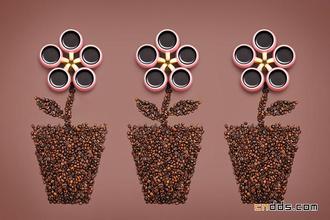Introduction to the grinding degree of Indonesian coffee bean planting mode brand taste and flavor description method
Coffee cultivation in Indonesia
A brief History of Coffee
In 1696, the then Governor of the Netherlands in Malabar, India, gave a batch of coffee seedlings to the Governor of the Netherlands in batavia in Batavia (present-day Jarkata in Jakarta). This was the first time that coffee was grown in Indonesia. However, the first batch of coffee seedlings were washed away by the flood. In 1699, Batavia accepted the gift again. This time, the coffee seedlings survived successfully and ushered in the first harvest in 1701, which began the coffee trip to Indonesia.
At first, coffee was grown in and around Jakarta, and then gradually expanded to central and eastern Java, as well as Sulawesi, Sumatra and Bali. At the same time, in eastern Indonesia, coffee was also grown in Flores on the island of Flores and Timor on the island of Timor in the Portuguese territory at that time, but the source of the coffee seedlings was different.
Indonesian coffee began to supply the European market in 1711, when Indonesia was the first country outside Africa and Arabia to grow coffee on a large scale. It became the world's largest exporter of coffee in the 1880s. The fame of Java coffee began here.
The prosperity of coffee in Indonesia was not sustainable, coffee production was fatally hit at the end of the 18th century, and leaf rust, originally found in West Java, spread rapidly, destroying the Arabica coffee estate in Indonesia. The leading position of the coffee trade was replaced by the American producing countries. However, it is worth mentioning that the leaf rust disaster did not affect the eastern Indonesian producing areas, namely Flores Island and Timor, where the genes of some coffee trees in Timor today can be traced back to the 16th and 17th centuries.
According to ICO, Indonesia ranked third in coffee production in the world in 2013, although 80% of it was Robusta.
Tall tree with bright red pointed leaves and long red cherry. It is generally a natural hybrid variety of iron pickup. Planting area Lake Toba, Aceh. The Netherlands brought this variety to be planted at high elevations on the island of Sumatra. Lost for a period of time is the restart of this rare specialty Arabica coffee beans on an organic farm in Lake dopa.
ANDONG SARI Anton sari
Kartika/Bourbon hybridization, Kadika / bourbon mixture. Medium tall trees with slender leaves with red tips, coffee trees with the best shadows, usually big cherries. Producing area: Aceh, Simalungun
KOPI LUWAK Coffee Coffee Kopi Luwak
Civets eat red coffee cherries, pull out poop coffee beans, thieves are expensive.

Important Notice :
前街咖啡 FrontStreet Coffee has moved to new addredd:
FrontStreet Coffee Address: 315,Donghua East Road,GuangZhou
Tel:020 38364473
- Prev

Introduction to the process of growing, harvesting, processing and processing of coffee beans
The method of picking coffee beans is to spread the coffee cherries widely on the exposure field for two weeks and sweep them with a rake several times a day so that the coffee beans can be dried more evenly. When dried, the coffee beans are separated from the skin, and the dried pulp and peel are removed by a sheller, then screened and divided into different grades. The best quality coffee can be produced by washing or drying.
- Next

Introduction to the characteristic Flavor description treatment of Sunshine Sidamo Red Cherry Plan Coffee Bean
Sun Sidamo Red Cherry Program National Ethiopian producing area Dala (Dara Zone), Sidamo producer Cabedo Local small Farmers Cooperative graded Grade 3 treatment mixed native species (Heirloom) data from Taiwan Coffee blog Organic Coffee blog above sea level. In short, it may be that more and more beans are exposed.
Related
- Guji coffee producing area of Guji, Ethiopia: Humbela, Shakiso, Wulaga
- What is the most expensive variety of Qiloso in BOP multi-variety group?
- How to store the coffee beans bought home?
- Why are Yemeni coffee beans so rare now?
- Ethiopian Sidamo all Red Fruit Sun Sun Santa Vini Coffee beans
- SOE is mostly sour? What does it mean? Is it a single bean? what's the difference between it and Italian blending?
- Is Italian coffee beans suitable for making hand-brewed coffee?
- How to choose coffee beans when making cold coffee? What kind of coffee beans are suitable for making cold coffee?
- Just entered the pit to make coffee, what kind of coffee beans should be chosen?
- Can only Japan buy real Blue Mountain Coffee? What are authentic Jamaican Blue Mountain coffee beans?

